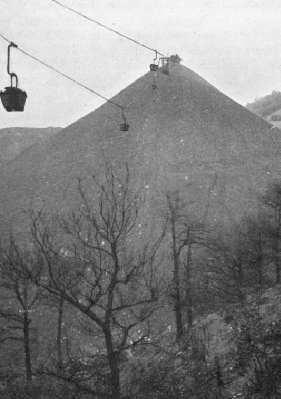PONTYPOOL GLYN PITS
Mine Waste

The Photograph above shows a typical pile of mine waste known as a Spoil Tip "slag heap" As soon as a mine was opened one of these tips would be seen to grow near the mine workings. The valleys of South Wales were covered with such tips, that was until 1966 when the disaster of Aberfan in South Wales was to shock the world. What had happened, was a watercourse had become covered by mine waste, with the result being that the tip became unstable due to the water build-up in its structure This build-up of water and the wet weather conditions at the time caused the whole tip to slip and then in its path, tear though houses and part of a school, resulting in the smothering of people, most of them children and their teachers, leaving a death toll which well exceeded 100 people. Since this disaster most of the dangerous tips have been levelled but although green at times, some parts occasionally slip and expose the underlying muck, reminding us that the stain on the valleys was man-made, a product of the mining industry. People should ask themselves why should all this waste be above ground anyway? Some would say that dumping like this was quite unnecessary, as the technology - called 'Stowing' existed then to replace it in the mine.
Stowing machines and all the equipment needed were available more than 70 years ago, long before a great deal of this waste came above ground in the first place. In a book on pneumatic stowing of mine waste, dated 1953, it stipulates that when taking out 100 tubs of coal, the area could be refilled with 60 tubs of waste, but after the 1984-1985 miners strike had ended, any chance of that was lost due to the speed each pit was closed and filled in. What a fine chance was missed here to help clean up our land.
The land we have to live in.